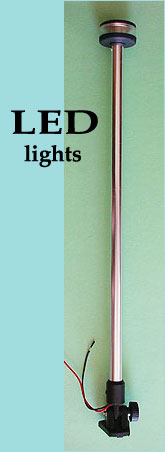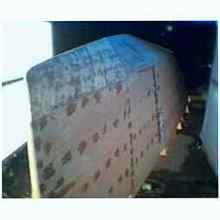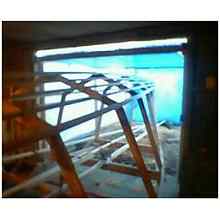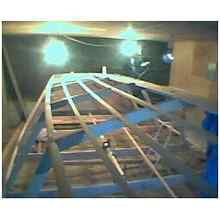Around three years ago I decided I wanted a 9 meter shoal draft yacht. I had considered two different options of construction - one being sheet plywood the other being strip planked Cedar. I came to the conclusion that plywood would be my best option for the type of yacht that I wished to own and cost.
The next was what would I design for a hull form and what would the sail plan consist of? Cost was always going to be the limiting factor and as an old and now deceased friend Yacht designer John Spencer had said to me early in my life, weight equals cost. Displacement was settled upon at 1500kg. I was offered a band new mainsail off a boat of the same size for next to nothing and a mast that had just been replaced with a composite one for a similar fee. The bulb for the centreboard was cast by a friend for basically the 500kg cost of the lead. A hard chine straight stem hull was drawn with minimal compound curve in each section.
The plywood was chosen. It was to be Maranti exterior with a marine bond. My family had used this 40 years ago to build 7 meter racing yachts which are still at the front of their fleet today, so we already knew the history of this material. The framework and the stringers and keelson would be made from Alaskan Yellow Cedar because it was light of weight and had similar properties to a New Zealand native timber Kahikatea which we have had experience with before. The hull would be sheathed with 18oz double bias E-Glass cloth, filled and faired with micro balloon filler.
I began construction in May 2010 with the construction of each frame which was drawn out on a 3.6 meter by 1.8 meter sheet of flooring particle board. Each frame was then made by cutting each piece of timber placing it on the outline of the drawn frame on the board and cutting plywood gussets for the chines and Keel line to hold it all together. There are nine permanent frames in all.
The next thing to be achieved was building a level base to stand the frames all up on as the shed floor certainly was not level. I created a frame with legs to the floor every one meter. I stood all the frames up and I trued them to make sure that they were all square and vertical.
Most of the timber I had purchased for the keelson and stringers came in 5 meter or 4 meter lengths so I had to scarf it to full length before I could fit the Keelson in for laminating. This was achieved by checking the frames out to house it flush when faired off then laminated in place. They were removed again and dressed and fitted to the straight stem post. The chines were constructed in the same manner. The stringers were scarfed to full length and fitted as well. Next, I faired the framework with a hand plane ready for the fitting of the sheets of plywood. I started fitting the plywood on the bottom from keel line to chine scarfing each joint and fitting a back plate as well between all stringers and chines and keelson. The bow would have to be planked in from approximately 1.2 meters back from the bow and this was achieved in 150mm strips at a 30 degree angle from the centreline. The main 9mm sheet had to be rebated 40mm to begin facilitating this so the planking would be staggered and the butt were joins far enough apart so as to not compromise strength. Fitting the side's panels was the same process but no planking in the bow.
I then cleaned off all the scarf joins and faired them through in preparation for fibreglassing. We began fibre glassing at 9 in the morning with two of us and 18 hours later we had completed the task. I left the boat for two days to cure off, and then applied a micro balloon epoxy filler mix for fairing.
This is where the boat is up to at this point.
Allan Roper, Designer, Builder, Owner |










